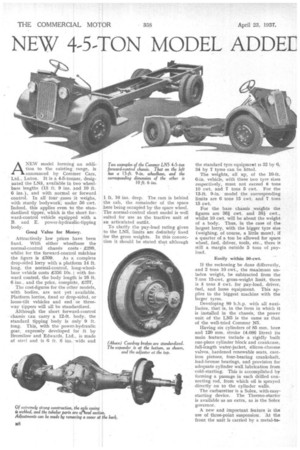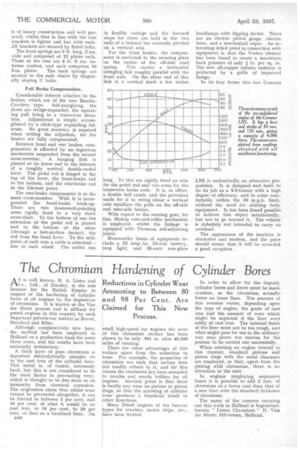NEW 4-5-TON MODEL ADDEF
Page 42

Page 43

Page 44

If you've noticed an error in this article please click here to report it so we can fix it.
ro COMMER RANGE Big-capacity 30-m.p.h. Model Available with Two Wheelbase Lengths and Without Rigid Bodywork Restrictions. Latest Cowdrey Brakes Standardized ANEW model forming an addition to the existing range, is announced by Cominer Cars, Ltd., Luton. It is a 4-5-ton6r, designated the LN5, available in two wheelbase lengths (13 ft. 9 ins, and 10 ft. 6 ins.), and with normal 9,r forward control. In all four cases lit weighs, with sturdy bodywork, undr 50 •cwt. Indeed, this applies even tcj the standardized tipper, which is th short forward-control vehicle equipp d with a B. and E. power-hydra lic-tipping body.
Good Value for Mocbey.
Attractively low prices have been fixed, With either wheelbase the normal-control chassis costs urbilst for the forward-control machine
the figure is £309. As a complete drop-sided lorry with a platform 14 ft. long, the normal-control, long-wheelbase vehicle costs £356 10s. with forward control, the body length is 16 ft. 6 ins., and the price, complete, R.271 7 .
The cost-figures for the otbler models, with bodies, are not yet available. Platform lorries, fixed or drop-sided, or loose-tilt vehicles and end or threeway tippers will all be standardized.
Although the short forward-control . chassis can carry a 12-ft. pody, the standard tipping body is only 9 ft. long. Thi,s, with the powei-hydraulic gear, expressly developed for it by Bromilow and Edwards, Ltd., is made of steel and is 6 ft. 6 ins. wide and 1 ft. 10 ins. deep. The ram is behind the cab, the remainder of the space here being occupied by the spare wheel. The normal-control short model is well suited for use as the tractive unit of an articulated outfit.
To clarify the pay-load rating given to the LN5, limits are definitely fixed for the gross weights. In this connection it should be stated that although
the standard tyre equipment is 32 by 6, 34 by 7 tyres can be fitted.
The weights, all up, of the 10-ft. 6-in, vehicle, with these two tyre sizes respectively, must not exceed 6 tons 10 cwt. and 7 tons 5 cwt. For the 13-ft. 9-in, model the corresponding limits are 6 tons 15 cwt. and 7 tons 15 cwt.
For the bare chassis weights the figures are 361 cwt. and 38i. cwt., whilst 10 cwt. will be about the weight of a body. Thus, in the case of the largest lorry, with the bigger tyre size (weighing, of course, a little more), if a quarter of a ton be allowed for spare wheel, fuel, driver, tools, etc., there is still a margin outside 5 tons of payload.
Easily within 50-cwt.
If the reckoning be done differently, and 2 tons 10 cwt., the maximum unladen weight, be subtracted from the 7-ton 15-cwt. gross-weight limit, there is 5 tons 5 cwt, for pay-load, driver, fuel, and loose equipment. This applies to the biggest machine with the larger tyres.
Developing SO b.h.p. with all auxiliaries, that is, in the form in which it is installed in the chassis, the power unit of the LN5 is the same as that of the well-tried Con-imer N5.
Having six cylinders of 85 mm. bore and 120 mm. stroke (4.086 litres) its main features include a rigidly built one-piece cylinder block and crankcase, full-length water-jacket, silicon-chrome valves, hardened renewable seats, castiron pistons, four-bearing crankshaft, lead-bronze bearings, and provision for adequate cylinder wall lubrication from cold-starting. This is accomplished by forming a passage in each drilled connecting rod, from which oil is sprayed directly on to the cylinder walls.
The carburetter is a Solex, with easystarting device. The Thermo-starter is available as an extra, as is the Solex governor.
A new and important feature is the use of three-point suspension. At the front the unit is carried by a metal-to-.
metal spherical mounting incorporated in the centre of the cross-bearer. Alternatively to the petrol unit a PerkinsLeopard oil engine may be specified.
A Borg and Beck 11-in, ventilated clutch is used, whilst, bolted to the bell-housing, is a gearbox of conventional type. It affords, in conjunction with the final drive, forward gear ratios of 6.57, 11.18, 19.5 and 41.6 to 1 and 69.3 to 1 reverse.
Power-to-weight Ratio.
With 32 by 6 tyres, a road speed of 37.5 m.p.h. is given in top gear at 2,500 crankshaft r.p.m. At maximum torque (176 lb.-ft. at 1,000-1,500 r.p.m. ) the road speed is 18-19 m.p.h. The high power-to-weight ratio (0.516 b.h.p. per cwt. minimum and 0.615 maximum) is noteworthy, whilst the axle and gearbox ratios have been selected to enable the vehicle to climb easily 1 in 30 in top gear and 1 in 41 in first gear.
Two interesting details relating to the gearbox are that the teeth of all gears are burnished before hardening and that the selector rods are polished to enhance the lightness of gearchanging.
In the transmission line there are, on the long chassis, three Layrub universal joints, and two on the short chassis, these having respectively twopiece and one-piece propeller shafts. The Commer concern, which adopted these joints relatively recently, speaks highly of the service they have given.
Final drive is by spiral bevel, the tail shaft being additionally supported by an outrigger bearing. A thrust-pad backs the crown wheel to relieve it of stress should sudden heavy loads cause slight distortion. It is of note that the tubular portions of the substantial cast-steel axle casing are of elliptical section, the major axis being vertical.
Of high-tensile steel, the frame side members, at their points of maximum section, are 8 ins. deer) and A in. thick, with 2i-in. flanges. They are
braced, independently of the engine, in six places—at the extreme front by a tube, by an inverted channel behina the gearbox, by a second tube, carrying below, it the self-aligning propellershaft bearing, which can easily be detached, and then by three channels. Of these last, that in line with the forward brackets of the back springs is of heavy construction an well gusseted, whilst that in line wi h the rear brackets is lighter and has wide ends. All brackets are secured by tted bolts.
The front springs are 3 ft. ong, 2 ins. wide and composed of 12 p ates each. Those at the rear are 4 ft. 6 ins, between centres, and each co prises 10
3-in. plates. The back springs are secured to the axle chairs y diagonally sloping U bolts.
Full Brake Compensailion.
Considerable interest atta. hes to the brakes, which are of the n v BendixCowdrey type. Self-ener zing, the shoes are wedge-expanded, lhe operating pull being in a transverse direction. Adjustment is simp y accomplished by a click-type exp ding fulcrum. No great accuracy s required when setting the adjuster 4, for the brakes are fully compensatd.
Between front and rear br es, cornpensation is afforded by an ingenious mechanism suspended from the second cross-member. A hanging link is pinned at its lower end to the fulcrum of a roughly vertical double-ended lever. The pedal rod is hinged to the top of the lever, the front brake rod to the bottom, and the rear brake rod to the fulcrum point.
The rear-brake compensat r is at the main cross-member. With it is incorporated the hand-brake hook-up. There are two downw -pointing arms rigidly fixed to a ery short cross-shaft. To the bottom f one the extension of the pedal rod is pinned and to the bottom of the other (through a lost-motion device), the rod from the hand lever. To the midpoint of each arm a cable is ttachedone to each wheel. The dables run. in flexible casings and the forward stops for these are held in the two ends of a balance bar centrally pivoted • on a vertical axis.
For the front brakes, the compensator is anchored to the securing plate on the centre of the off-side road spring. This carries a horizontal swinging link roughly parallel with the front axle. On the other end of this link is a vertical shaft a few inches long. To this are rigidly fixed an arm for the pedal rod and two arms for the transverse brake rods. It is, in effect, a double bell crank, and the provision made for it to swing about a vertical axis equalizes the pulls on the off-side and near-side brakes.
With regard to the steering gear, for this. Bishop cam-and-roller mechanism is employed, whilst the linkage is equipped with Thomson self-adjusting joints.
Noteworthy items of equipment include a 72 amp.-hr. 12-volt battery, stop light, and 36-watt non-glare
headlamps with dipping device. There are an electric petrol gauge, electric horn, and a mechanical wiper. An interesting detail point in connection with equipment is that the Vortex silencer has been found to create a maximum back pressure of only i• lb. per sq. in. The new all-copper tubular radiator is protected by a grille of improved design.
In its four forms this new Commer LN5 is undoubtedly an attractive proposition. It is designed and built to do its job as a 4-5-tonner with a high degree of efficiency, and to come comfortably within the 30 m.p.h. limit, without the need for stinting body equipment. It has been found possible to achieve this object satisfactorily, but not to go beyond it. The vehicle is definitely not intended to carry an overload.
The appearance of the machine is attractive and modern, and the price should assure that it will be accorded a good reception.




























































































